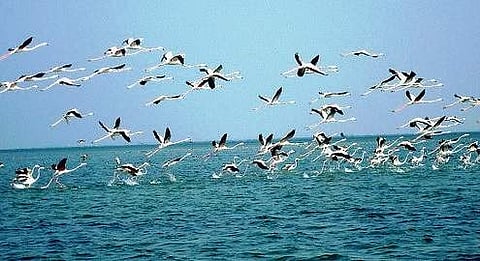

BHUBANESWAR: Contrary to notions that Chilika lagoon is almost free of metal contaminants, a latest scientific study has found continued presence of four different heavy metals which may affect the wetland’s eco-system and biodiversity in the long run.
A research paper in “Current Science” pointed out that the lake’s soil sediment has presence of cadmium (Cd), mercury (Hg), lead (Pb) and cobal (Co). Water and sediment samples were collected from Rambhartia, Balugaon and Kalupadaghat for the study. While Rambhartia is near the sea mouth where salinity level is high, Balugaon is in brackish water zone and Kalupadaghat in freshwater region.
Among 20 metals analysed by the research team of Department of Biochemistry of University of Calcutta, Iron (Fe) was found significantly high in concentration at all three sampling sites with the highest concentration at Kalupadaghat. The research also indicates that contamination factor and enrichment factor values for lead was higher at Kalupadaghat.
While lead concentration at Rambhartia and Baluagoan could be categorised as ‘unpolluted’, Kalupadaghat could be considered as “an unpolluted to moderately polluted zone”, the report said adding, the elevated level of lead in the freshwater zone could be attributed to the municipal wastes carried along with the sediment of river Mahanadi.
Similarly, total concentration of cadmium was high at all three stations. Chromium concentration was found at Kalupadaghat and attributed to cement dust, contaminated landfill and effluents from chemical plants brought by the Mahanadi. Similar was the case with Cobalt at Kalupadaghat.
However, the study found no zinc concentration in the sampled areas of the lagoon though it recorded copper at Rambhartia and Balugaon. This metal is believed to have been released in the environment mostly from industrial and domestic waste carried by Mahanadi.
Mercury concentration was found at Rambhartia though the station near the sea mouth was not affected by sediment carried by Mahanadi. The higher mercury contamination is believed to have been caused by natural sources.
The analysis also showed that all metals, except mercury, showed a negative relation with salinity. While mercury was in high concentration at Rambhartia, the mouth of the sea, other metals were high in Kalupadaghat where salinity is low.
“Slow absorption of these heavy metals in the sediment may induce severe damage to the ecosystem as well as biodiversity of the lake. The correlation between heavy metal concentration and salinity gradient indicates that the source of contamination is predominantly the sediment carried by the Mahanadi riverine system,” the report said.
However, it concluded that Chilika is less polluted than Mahanadi and Godavari rivers and the comparative account of different pollutants indicates that all metal except cadmium have decreased over past 20 years indicating a positive outcome of Chilika Management Plan.